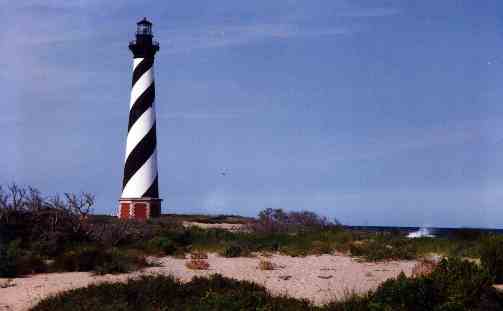
Beaches
Adventure Travel Planning Since 1995
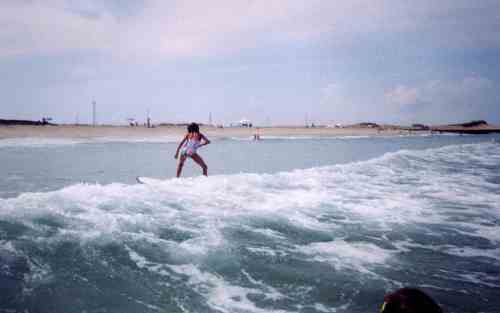
| Route 66 | Cities | Beaches |
 |
Beaches Adventure Travel Planning Since 1995 |
 |
| Lighthouse
|
Ocracoke
|
Hatteras
|
Portsmouth |
Keys |
Padre Island |
Presque
Isle |
Cape Cod |
Cannon
|
Old Orchard |
|
If there's a high school student out there anywhere
who doesn't love the beach, we sure haven't met them. But as outdoor adventurers,
our taste in beaches differs slightly from some of our friends. They look
forward all year to Spring Break in Florida and summer family vacations
at Myrtle Beach. We find those places offensive. When we go to the beach,
we go for an encounter with Nature. We don't want malls, fast food joints
and carnival rides up on boardwalks. We don't want high rise hotels looking
down on us and five thousand little personal shelters lined up to the
horizon. We don't want wall to wall people. We don't want grooming machines
out there at 3 a.m. sifting and raking and levelling the sand into a picture
perfect but totally artificial surface. We don't want screens hidden out
in the water to keep shells, fish, driftwood and seaweed from coming to
shore. And we don't want vendor stands down on the sand. |
What we do want are plenty of sea critters. We love
bobbing out there in the surf while porpoises play around us. We like
brown pelicans flying low over the water, occasionally diving in to our
right and coming up to our left with a fish in their beak. We like fish
nibbling at our toes. We like the occasional manta ray either sliding
through under water or, at dawn or dusk, skimming just above the surface
for the insects hovering there. We like sitting on our blanket or beach
chair watching ghost crabs darting around, digging out their tunnels,
sometimes sideways walking right up close and fastening those stalkborne
eyes on us. We like watching the horseshoe crabs and the sea turtles struggling
up out of the surf at high tide. We like big waves, waves we can surf
with boards or our bodies, waves we can bob in with an inner tube and
every so often get totally hurled up on the sand and lay there dazed for
a minute before going back. |
|
l. Lighthouse Beach at Buxton,
North Carolina, is the greatest Real Beach in the Eastern U.S. It sits
out there on Hatteras Island, 100 miles off the mainland, three hours
on the ferries from Cedar Point. If you look at a huge map, it sits precisely
where land that has been coming steadily south for hundreds of miles suddenly
makes a right turn and heads westward, creating an L-shaped sand elbow
known as Cape Hatteras. The greatest lighthouse in North America sits
just off the beach, and for a mid day break you can put on your sandals
and go climb it. You can camp over in the dunes a few minutes away. One
of the largest maritime forests left on the continent comes right up to
the edge of the beach, complete with hiking trails and teeming with wildlife.
Families love this beach because the National Park Service provides lifeguards
and shallow water extends a quarter of a mile out so little kids can bob
safely in inner tubes or learn to swim. But out beyond the bars, the waves
are big time. This is the famous Wave Magnet, the East Coast surfing mecca..
|
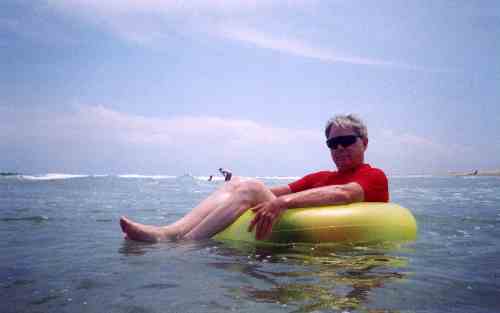 |
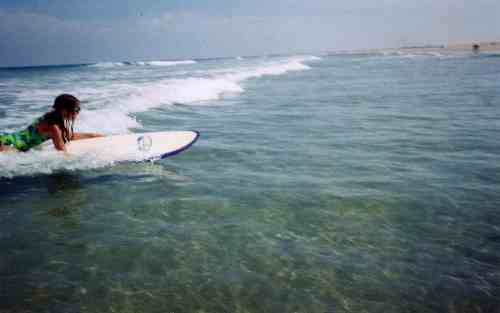 |
2. Ocracoke Island. The whole
14 mile front of it. You take a two and a half hour ferry out from Cedar
Point. You can rent a cottage in the village of Ocracoke, or camp out
in the dunes, where showers and rest rooms are provided by the National
Park Service and you're a hundred feet from the surf. You're southeast
of the Cape here, so you're in the Gulf Stream and the water is warm.
The waves are not cutting edge like below the Lighthouse, but they're
big enough. This is one of the prime Cocquino habitats in North America,
so enjoy the entertainment. With each outwash, several thousand tiny mussels
emerge from the sand, feed by straining outgoing water through their strainers,
then dive back down a split second before the next wave. They're not big
enough to collect (you can hold 20 in one hand) but they're beautiful
under a magnifying glass. Don't worry about crowds; away from the campground
and two parking turnouts you may be the only people in sight. No bars
or wide shallows here, so not as good for children, but a great swimming
beach. |
|
3. Hatteras Island Front Beaches. From Buxton north to Oregon Inlet. That's 40 miles. There are two towns, Avon and the merged strip of Salvo, Waves and Rodanthe. The intervening stretches of nine, 20 and nine miles are pretty isolated. Surf fishermen walk over from the highway, and a few beach rats drive out in their buggies. Otherwise, you're alone. Great waves, gradual dropoff, bars here and there, dunes towering to the west, separating you from the road. 4. Portsmouth Island. 40 miles of outer banks wilderness. You have to take the ferry over from Ocracoke or kayak your way the few miles across the inlet. The ghost town of Portsmouth used to be the largest port in North Carolina but the currents shifted and shallowed up the inlet and harbor while deepening others further North and South. The homes are still here, but the only permanent residents are National Park Service rangers. One of the two greatest shelling beaches in the North Atlantic. Great stretch for beach backpacking, sea kayaking, and beach camping. |
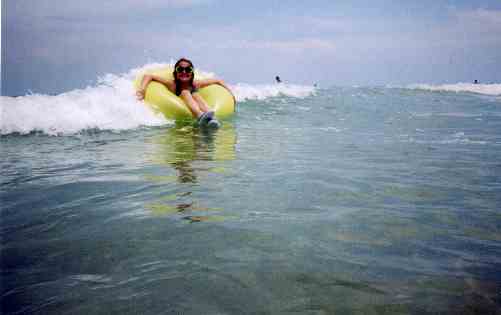 |
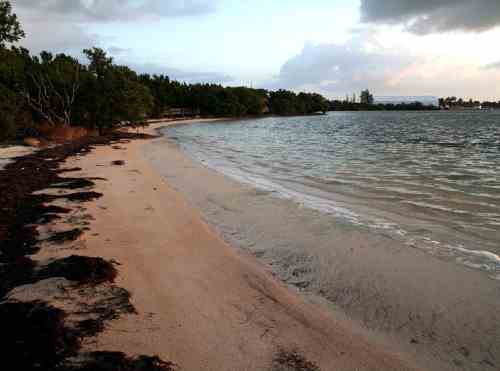 |
5. The Keys. The Boy Scouts of America bought one of them and uses it as a high adventure outpost, so we're familiar with the beaches there. But by sailing and kayaking, we've landed on all of them down to Key West. These are the greatest snorkeling and scuba diving beaches in the U.S. due to warm, calm, clear water. These aren't the touristy white sugar Florida beaches. Keys beaches are narrow, with brown sand. The shallows extend out half a mile, so there are no surfable waves. But the water is tropical warm, very calm, very clear, and ideal for bobbing on a raft or looking for shells. 6. Padre Island, Texas. 100 miles of barrier island semiwilderness. Unlike Carolina's Outer Banks, the park service got here first, and has never allowed development. so there are no towns, no hotels, no permanent facilities at all. You're right on the Mexican border, far South in the Gulf/Caribbean ecozone. Beautiful sand, great wave action, Central American and Caribbean shells. But get here in June. The place gets risky in hurricane season. |
|
7. Presque Isle. Pennsylvania's state park on Lake Erie. If the state hadn't got here first, this would be a national park. The only freshwater beach on our top 10. 14 miles of beautiful beach. The water is colder and the wave action much less, but this is one of the great windsurfing spots in North America because the peninsula jutting out into the lake catches and funnels the wind. It is also a great swimming beach, free of the distractions of surfing or tubing. 8. Wellfleet Beach, Cape Cod. A walk on the wild side. Northern, windy, cold, with towering dunes. The North Atlantic Drift and Labrador Current wash up here, so shelling is sparse but offers different varieties. When the wind comes out of the North (which is about half the time), surfing is excellent. On other days, tubing is great because there is more inshore churning action. Constantly curving high dunes frame every scene, so this may be the most photogenic beach in the country. If you camp here, make sure everything is braced for winds. Village of Wellfleet uncommercialized. Ocean, pond and bay beaches. Oystering license only $50. Great fishing and oneof America's classic drive in movies a mile inshore. |
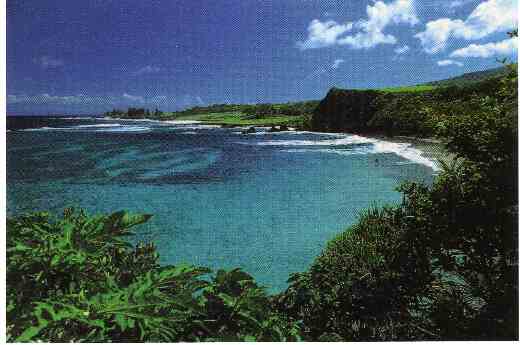 |
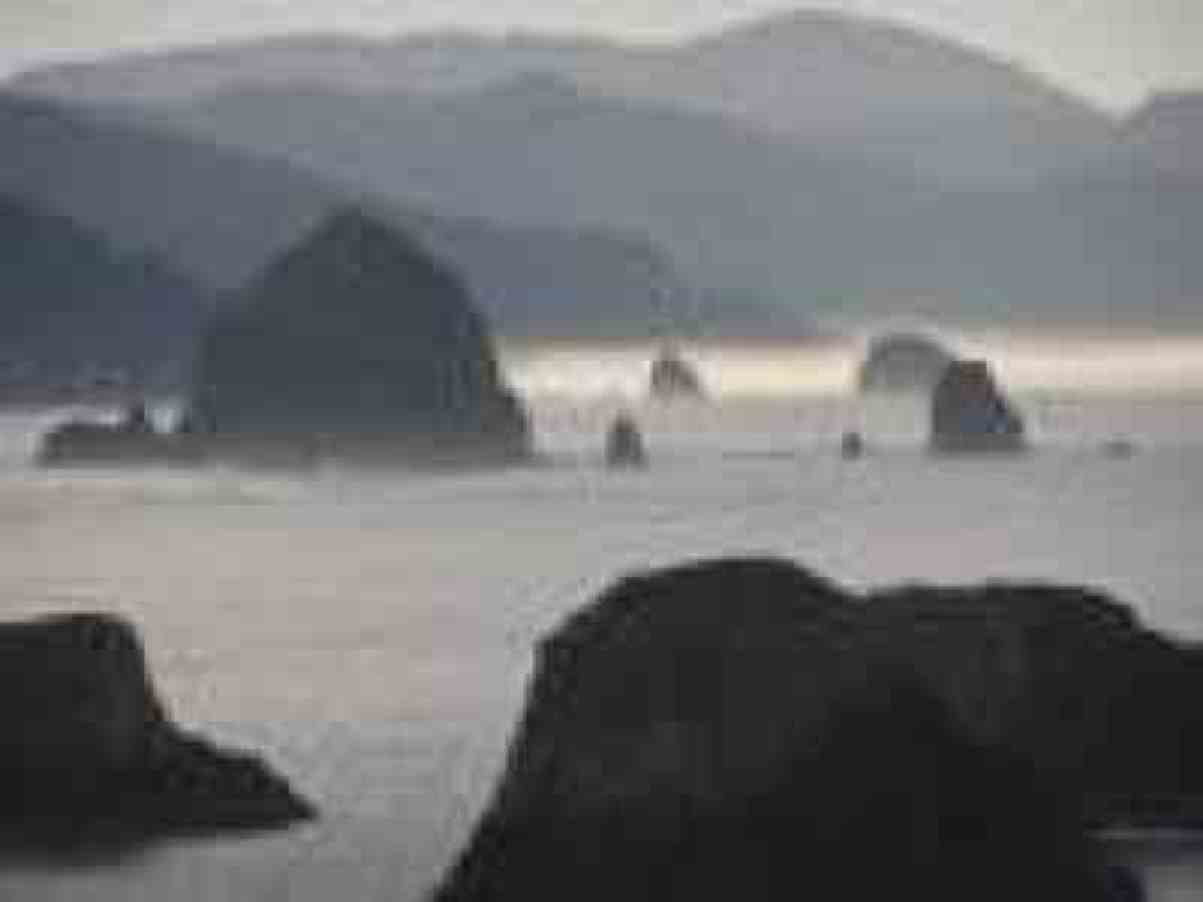 |
9. Cannon Beach, Oregon. Not a swimming beach, but worth driving thousands of miles to see. Extreme tides here lay bare wide expanses of bottom punctuated by huge rock pinnacles. Rivers wash driftwood and whole trees down from the mountains and thousands of sea creatures inhabit the shallow pools, rocks and cliffs. Whales, seals, crabs, mollusks and birds. But watch the time and water. When the tide turns, it comes back with a rush, and getting caught out on the flats can be fatal. 10. Old Orchard Beach, Maine. Seven mile strand is the most civilized beach on our list. Homes, motels, bed and breakfasts and parking lots line the sand. But it's still not crowded. The water temperature is tolerable on sunny windless days. It's not a surfing location, but is good for tubing and swimming and offers shellers varieties from further North. Campsites are hard to find, but this is the bed and breakfast capital of the whole east coast. |
Comment or
Question ?? Join us at The
Forum. |
Read our day to day adventures at the Blog |
Or contact us at trekkerforrest@aol.com |